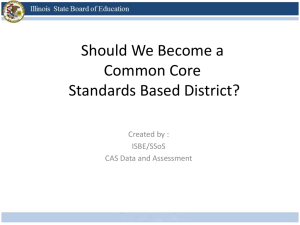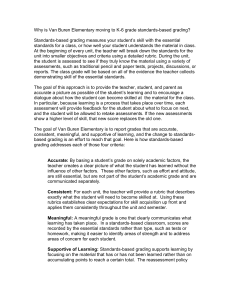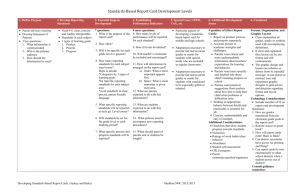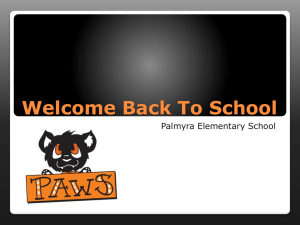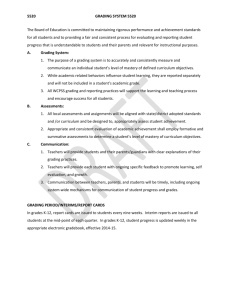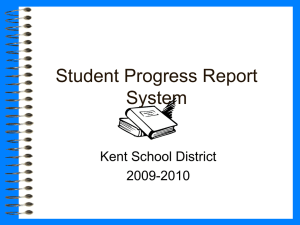Grades that Mean Something
advertisement
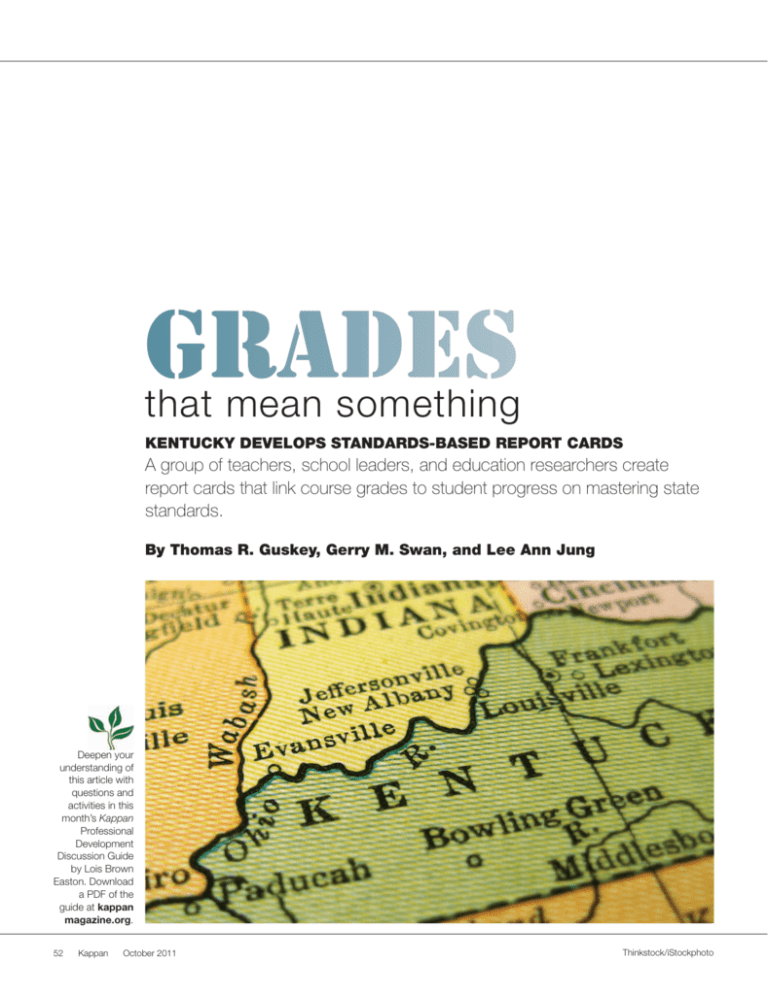
Grades that mean something KENTUCKY DEVELOPS STANDARDS-BASED REPORT CARDS A group of teachers, school leaders, and education researchers create report cards that link course grades to student progress on mastering state standards. By Thomas R. Guskey, Gerry M. Swan, and Lee Ann Jung Deepen your understanding of this article with questions and activities in this month’s Kappan Professional Development Discussion Guide by Lois Brown Easton. Download a PDF of the guide at kappan magazine.org. 52 Kappan October 2011 Thinkstock/iStockphoto Comments? Like Kappan at www. facebook.com/pdkintl N early all states today have standards for student learning that describe what students should learn and be able to do. Nearly all states also have large-scale accountability assessment programs designed to measure students’ proficiency on those standards. Despite these commonalities, schools in each state are left to develop their own standardsbased student report cards as the primary means of communicating information about students’ performance on state standards. Although school leaders would undoubtedly like to align their reporting procedures with the same standards and assessments that guide instructional programs, most lack the time and resources to do so. Those few leaders who take up the challenge rarely have expertise in developing effective standards-based reporting forms and inevitably encounter significant design and implementation problems (Guskey & Bailey, 2010). To help Kentucky educators address this challenge, we worked with a group of teachers and school leaders to develop a common, statewide, standardsbased student report card for all grade levels. While some Canadian provinces have used standards-based report cards for many years, Kentucky educators are the first in the U.S. to attempt such a statewide reform. Data from the early implementation demonstrate that schools can implement more effective ways of communicating student learning with little additional work by teachers and that parents and community members can be strong supporters of such reforms. This shows great promise for revolutionizing reporting systems in Kentucky and elsewhere. STANDARDS-BASED GRADING Grades have long been identified by those in the measurement community as prime examples of unreliable measurement. Huge differences exist among teachers in the criteria they use when assigning grades. Even in schools where established policies offer guidelines for grading, significant variation remains in individual teachers’ grading practices. The unique adaptations teachers use in assigning grades to students with disabilities and English learners make that variation wider still. These varying grading practices result in part THOMAS R. GUSKEY (guskey@uky.edu) is a professor of educational psychology, GERRY M. SWAN is an assistant professor of curriculum and instruction, and LEE ANN JUNG is an associate professor of special education in the College of Education at the University of Kentucky, Lexington, Ky. © 2011, Thomas R. Guskey. from the lack of formal training teachers receive on grading and reporting. Most teachers have scant knowledge of various grading methods, the advantages and shortcomings of each, or the effects of different grading policies on students. As a result, most simply replicate what they experienced as students. Because the nature of these experiences widely vary, so do the grading practices and policies teachers employ. Rarely do these policies and practices reflect those recommended by researchers and aligned with a standards-based approach. Standards-based approaches to grading and reporting address these grading dilemmas in two important ways. First, they require teachers to base grades on explicit criteria derived from the articulated learning standards. To assign grades, teachers must analyze the meaning of each standard and decide what evidence best reflects achievement of that specific standard. Second, they compel teachers to distinguish product, process, and progress criteria in assigning grades (Guskey, 2006, 2009). THE KENTUCKY INITIATIVE We began our standards-based grading initiative in Kentucky by bringing together educators from three diverse school districts who had been working to develop standards-based report cards, unaware of each other’s efforts. District and school leadcan ers, along with teacher leaders implement more effective from each district were invited ways of communicating to a three-day, summer workshop on standards-based report student learning with cards led by researchers with ex- little additional work by pertise in grading and reporting teachers; parents and policies and practices. community members can The first part of the work- be strong supporters of shop focused on the unique such reforms. challenges of standards-based grading, recommended practices in grading and reporting, and methods of applying these practices to students with disabilities and English learners. The second part featured school leaders and teachers working to create two standards-based reporting forms: one for grades K-5, and another for grades 6-12. Both report cards included guidelines for reporting on the achievement of students with disabilities and English learners in a standards-based environment (Jung, 2009; Jung & Guskey, 2010). Schools DEVELOPMENT PROCEDURES Kentucky has adopted the Common Core State Standards Initiative (CCSSO, 2010). So, the first V93 N2 kappanmagazine.org 53 step was reducing the long lists of student learning standards in language arts and mathematics outlined in the Core to between four and six clear and precisely worded “reporting standards” expressed in parent-friendly language. That’s because teachers find it burdensome to keep detailed records for every student on large numbers of distinct standards in each subject area, and parent surveys revealed that more than six standards in a given subject area would only overwhelm them with information (Guskey & Bailey, 2001). The final “reporting standards” for language arts and mathematics closely resembled the “strands” or “domains” under which the curriculum standards are grouped in the Core. We began with the language arts subdomains of Reading, Writing, Speaking/Listening, and Language. In each of these areas, there can be as many as five individual reporting standards. FIG. 1. Example of an Elementary Report from the Standardsbased Report Pilot Standards Based Report Elementary Report Card Student: Chris Lipup Reporting Period: 3 4 3 2 1 N/A Standard Marks Exemplary Proficient Progressing Struggling Not Assessed ++ + – N/A Process Marks Consistently Moderately Rarely Not Assessed *Based on modified standard(s). See Progress Report Grade 2 Language Arts – Ms. Bausch Reading Writing Speaking Listening Language 4 3 2 3 4 Process Goals Preparation Participation Homework Cooperation Respect + ++ + + ++ Description/Comments: Students have been very busy during the 3rd reporting period working on the following topics: consonants, vowels, and their corresponding sounds; identifying syllables in words; stressed and unstressed syllables; closed syllables, vocabulary development; compound words, antonyms; homophones; synonyms, multiple meaning words; idioms; comprehension skills; main ideas and supporting details; fluency; and reading strategies such as sequencing, cause and effect, and facts and opinions. We also worked on how to answer open-response questions. Chris is improving with the articulation difficulties that we recently observed. We are coordinating efforts with the speech therapist to continue the progress we’ve made into the next marking period. Grade 2 Mathematics – Mr. Reedy Operations and Algebraic Thinking Numbers and Operations — Base 10 Numbers and Operations — Fractions Measurement and Data Geometry Mathematical Practices 3 3 2 2 N/A 3 Process Goals Preparation – Participation ++ Homework – Cooperation ++ Respect + Description/Comments: Over the past nine weeks students have been learning about measurement, probability, and data analysis. They explored their world with the concepts of measurement and used tools and units to measure objects in the classroom and at home. They learned that probability can be fun by using Skittles candies to predict the chance of an event. We also learned about numbers on a spinner and how to describe probability using words such as “impossible,” “likely,” and “not likely.” Students learned when and why to use different types of graphs. They created graphs for specific situations and learned that graphs must have titles, labels, x-axis, y-axis, and scale. We even made a classroom grid to identify ordered pairs. Chris has had a pretty successful marking period, although homework and preparation continue to be issues. Most of the problems Chris is experiencing with measurement and fractions stem from not practicing enough to build a level of fluency. We will begin the next reporting period with supervised study to see if we can help Chris develop better out-of-class study habits. 54 Kappan October 2011 In Reading, for example, the possible options for reporting standards include Foundational Skills, Key Ideas and Details, Craft and Structure, Integration of Knowledge and Ideas, and Range of Reading, and Level of Text Complexity. The mathematics strands included Operations and Algebraic Thinking, Number and Operations — Base Ten, Number and Operations — Fractions, Measurement and Data, Geometry, and Mathematical Practices. Reporting standards for other subjects were developed through a similar process, based on the standard strands set forth by leading national organizations. Specifically, we used standards developed by the National Science Teachers Association (1996), National Council for the Social Studies (2010), Consortium of National Arts Education Associations (1994), National Association for Music Education (1994), and National Association for Sport and Physical Education (2004). Using the broad strands described by these national organizations to develop our reporting standards also meant that minor revisions in particular curriculum standards would not necessitate significant change in the content or format of the report cards. Another important development step was offering separate grades or marks for “product” criteria related to academic performance, “process” criteria associated with work habits, study skills, responsibility,and behavior, and “progress” criteria that describe learning gain. The report cards also included sections for teacher, parent, and student comments. We then built an Internet-based application where teachers could record information on student performance, tally that information to determine grades and marks, and print and distribute report cards. We used open source software that can run on the most basic web infrastructure. Finally, we made plans to provide all participating schools with face-to-face, online, and telephone support. We scheduled follow-up sessions for each school and provided specific technical support when requested by a school leader or staff member. We also made several presentations to schools’ site-based councils comprising the school principal, teachers and parents. REPORT CARD STRUCTURE, FORMAT Figures 1 and 2 illustrate portions of draft forms of our elementary and secondary Kentucky Standards-based Report Cards. The first page of the each report card includes the student’s photograph, name, address, and grade level, along with information about the school and a statement of the report card’s purpose. The pages in the figures follow and provide the standards-based information about a student’s school performance. We included the names and photographs of each student’s teachers to personalize the report cards, and to familiarize families with each child’s teachers. The underlying structure of the report card is based on course rosters exported digitally from each school’s information system. ELEMENTARY REPORT CARDS FIG. 2. Example of a Secondary Report from the Standards-based Report Pilot Standards Based Report Elementary Report Card Student: T. Neduts Reporting Period: 1 Achievement Grades A Exemplary B Proficient C Progressing D Struggling U Unsatisfactory Standard Marks 4 Exemplary 3 Proficient 2 Progressing 1 Struggling N/A Not Assessed ++ + – N/A Process Marks Consistently Moderately Rarely Not Assessed *Based on modified standard(s). See Progress Report Algebra 1 – Mathematics 200: Mr. Parker The elementary report card figure shows Academic Achievement C the section devoted to language arts and Process Goals Operations with real numbers 4 Participation ++ Linear equations and inequalities 3 mathematics. Each subject has specific conHomework – Relations and functions 2 Cooperation ++ Polynomials 2 tent strands so teachers can offer separate Punctuality + Quadratic, cubic, and radical equations 1 grades or marks for each. Although this reMathematical reasoning and problem solving 2 quires teachers to keep more detailed records Description/Comments: This reporting period we studied probability, statistics, and the beginning units of Algebra I. We completed units of student performance, families get more on solving one-variable equations and applying one-variable equations to real world situations. Our next major unit of study will be linear functions. We included the following mathematics standards: measures of central tendency, explicit information about a student’s learnchoosing appropriate graphs, interpreting graphs, misleading statistics, polygons, lines and angles. We will conclude the geometry unit at the beginning of the next quarter. Taylor needs to work on focus and attention during class. ing strengths and areas where a student may be struggling. Taylor also had several low assessment scores but chose not to retake them. With improved attention and retaking low assessments, I am sure Taylor’s grades will improve rapidly. To provide more precise information about each reporting standard, teachers and school Biology 1 – Science 205: Mrs. Krall leaders are working with content-area specialists to develop an online curriculum resource Academic Achievement A Process Goals Basis of scientific inquiry 4 that identifies specific content and skills proParticipation + Physical, chemical, and cellular basis of life 3 Homework ++ Continuity of life and the changes of organisms over time 2 moted by the standard and can be accessed Cooperation + Unity and diversity of life 3 Punctuality – Ecological relationships among organisms 4 anytime by families. This will allow families Description/Comments: to learn, for example, which writing skills in During this quarter we worked on the chemistry foundations for understanding biology. This included the following standards: properties of matter, the Periodic Table, chemical bonding, and balancing chemical equations. language arts were addressed during the first marking period of 2nd grade or what aspects Taylor has done an outstanding job this reporting period. Independent work was very thorough and extremely well done. Taylor grasps ideas very quickly and sometimes moves on without understanding it thoroughly. I was very happy of measurement and data were the focus of to see Taylor break that habit and really keep on top of the material. math instruction during the second marking period of 4th grade. Physical Education – Team Sports 200: Mrs. Sandidge Teachers also record marks for Process Academic Achievement B Process Goals Demonstrates competency in motor skills and movement patterns 2 Goals related to preparation, participation, Participation ++ Demonstrates understanding of movement concepts, principles, 3 strategies and tactics Homework – homework, cooperation, and respect. FamiEngages regularly in physical activity Cooperation 2 + Achieves and maintains a health-enhancing level of physical fitness Punctuality 2 + lies have online access to information about Exhibits responsible personal and social behavior that respects self 3 and others each goal, along with rubrics for determinValues physical activity for health, enjoyment, challenge, self3 expression, and/or social interaction ing the marks. For example, the homework rubric states: Description/Comments: In this reporting period students were introduced to the basic skills and techniques of basketball. They practiced Consistently: All homework assignments dribbling, passing, shooting, footwork, rebounding, defense, and combining individual offensive and defensive techniques into play patterns. were completed during the marking period Taylor excelled in footwork and defensive positioning, and felt much more comfortable playing defense. Offense was with a high level of accuracy. more of a struggle for Taylor, mostly because of a lack of confidence in individual ball-handing skills. We will revisit Moderately: Most homework assignbasketball in the next reporting period. I have given Taylor a set of drills to help develop basic scoring moves that should help enhance that offensive confidence. ments were completed during the marking period with a fair level of accuracy. Rarely: Numerous homework assigngoals in sections labeled Work Habits, Study Skills, ments were missing during the marking period and/ or Citizenship, and mark these only once on the or the work was often inaccurate. These represent the process goals that the devel- reporting form. The teachers and school leaders opment team considered most important at the el- who developed our form strongly believed, however, that families need to know if students behave ementary level. Team members debated long and hard differently during instruction in different subject about including “effort” as a process goal, for example, but abandoned it when they could not reach consensus areas. In the final section for Description/Comments, on appropriate criteria for judging “effort.” Many elementary report cards include process the reporting platform allows for two types of comV93 N2 kappanmagazine.org 55 ments. The first part consists of two or three sentences explaining more precisely the emphasis of instruction during the marking period, adding detail to the online description. The report card of every student in the class includes these sentences. Then teachers can access individual student’s records, and add a sentence or two about a particular student’s performance. Frequently, teachers offer specific suggestions for helping students. SECONDARY REPORT CARDS The secondary report card in Figure 2 also includes the names and photographs of each student’s teachers. We also merged the class schedule program with our reporting program so that courses shown on the report card correspond with student schedules. Because teachers and parents were reluctant to abandon traditional letter grades completely, the secondary report card includes an academic achievement (product) grade for each subject area or course. This grade is used to determine course credit and to calculate grade point families favored the averages (GPA) when necessary. We standards-based form did not give teachers specific direcover the traditional form. tions about how to construct this achievement grade except to say that it should reflect only academic factors and provide an accurate and defensible representation of what students learned in relation to the established learning standards at that point in the school year. We stressed that the achievement grade must be based on the most current evidence of a student’s academic performance and can’t include nonacademic factors related to work habits or class behavior. Below the overall achievement grade are Standard Marks for individual standards established for each course. Similar to the elementary report card, these were derived from standard strands established by leading national organizations in each content area. Families eventually will have online access to the performance rubrics for individual Standard Marks. Our plan is to include examples based on student work with many of the rubrics. Beside the Standard Marks are Process Goals related to Participation, Cooperation, Homework, and Punctuality. Like the elementary form, the rubrics for determining these marks are available online. Team members were particularly insistent on a separate mark for homework to ensure that teachers don’t include it as part of the achievement grade. Below the grade and marks lies the Description/ Comments section where teachers enter descriptions of the specific concepts and skills addressed during By a wide margin, 56 Kappan October 2011 that marking period. The descriptions include general statements for the class and individual comments about each student’s performance. Both elementary and secondary report cards allow the teacher to attach custom-scoring criteria for students who may be working on modified standards. The specific strategies developed to support those modifications can then be described in the Individual Education Program (IEP), English Learner (EL) plan, or intervention plans provided to families. PILOT IMPLEMENTATION Following the summer workshop, the educators returned to their schools and encouraged other teachers to pilot the new report cards. Participating teachers distributed two report cards to families of 2,093 students for each of the first two quarterly (nine-week) marking periods. One was the traditional report card that had been used in previous years; the other was the newly developed standardsbased report card. At mid-year, after the second distribution of the new report cards, we did an online survey with all participating teachers to learn about their experiences, specifically the time and effort required to gather information, complete, and distribute the report cards. At the same time, we surveyed families of all students who received the new report card to learn their impressions. Both surveys included several common items so that we could compare teachers’ and parents’ perceptions of the quality and clarity of the information included in the report cards. Overall, 59% of participating teachers and 45% of families completed and returned our surveys. Teachers were nearly unanimous in agreeing that the standardsbased reports provided better and clearer information, and that families found them easy to understand. Although they said completing the standards-based report cards required more time, most teachers indicated that the quality of information they could provide made the extra effort worthwhile. Parents’ and guardians’ perceptions mirrored those of the teachers. And by a wide margin, families favored the standards-based form over the traditional form. In their written comments, the parents of a few secondary students said they were concerned about not having a percentage grade to go along with achievement grade and standards marks. One parent said, “I’m not sure what ‘Exemplary,’ etc. means in terms of where they stand with the rest of the class. I know what a 97% means.” Another parent wrote, “I would still like to see a number or percentage (like 97%, 98%, etc.), not just an A, B, or C.” Interestingly, every example of a percentage grade offered by a parent was above 95%. No one mentioned, for example, the importance of knowing the difference between a 75% and 78%. implementation within three to five years. FUTURE PLANS Council of Chief State School Officers & National Governors Association Center for Best Practices (2010). Common core state standards initiative. Washington, DC: Author. www. corestandards.org/the-standards. Based on feedback from teachers and parents, we’re revising the reporting forms, and enhancing the professional development assistance and technical support offered as we expand implementation. This scaling-up process will take place on three levels. First, several schools in the three pilot districts are using the standards-based report cards schoolwide during the 2011-12 school year in place of the traditional report card. Both online support and follow-up sessions will be provided for the staffs of these schools. Second, staff members from other schools in these districts will take part in brief, three-hour training sessions on the new forms, led by teachers already using the forms. These sessions will explain how the new forms were developed, the rationale behind their structure and format, recordkeeping procedures, and the available technical support and follow-up assistance. Third, the revised forms will be presented to leadership teams from as many as 20 other Kentucky school districts to solicit their participation in a larger scale, piloting effort. We hope this will provide the basis for statewide References Guskey, T.R. (2006, May). Making high school grades meaningful. Phi Delta Kappan, 87 (9), 670-675. Guskey, T.R. (2009). Grading policies that work against standards . . . and how to fix them. In T. R. Guskey (Ed.), Practical solutions to serious problems in standards-based grading (pp. 9-26). Thousand Oaks, CA: Corwin. Guskey, T.R. & Bailey, J.M. (2001). Developing grading and reporting systems for student learning. Thousand Oaks, CA: Corwin. Guskey, T. R. & Bailey, J. M. (2010). Developing standardsbased report cards. Thousand Oaks, CA: Corwin. Jung, L. A. (2009). The challenges of grading and reporting in special education: An inclusive grading model. In T. R. Guskey (Ed.), Practical solutions for serious problems in standardsbased grading (pp. 27-40). Thousand Oaks, CA: Corwin. Jung, L.A. & Guskey, T.R. (2010, February). Grading exceptional learners. Educational Leadership, 67 (5), 31-35. American Public University You are1 degree away from changing your world. Which 1 will it be? Y ou are one degree away from achieving more. American Public University has 87 online degrees. Our tuition is far less than other top online universities so you can further your education without breaking the bank. You are one click away from making it happen. Graduate level courses start monthly at only $325 per semester hour. Learn more about one of the best values in online education at studyatAPU.com/kappa APU was recognized in 2009 and 2010 for excellence in online education by the prestigious Sloan Consortium. Text “APU” to 44144 for more info. Message and data rates may apply. V93 N2 kappanmagazine.org 57
